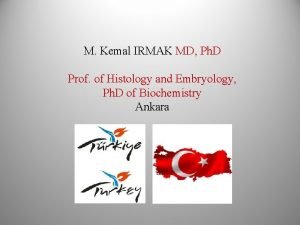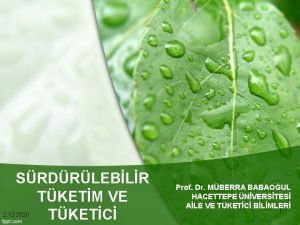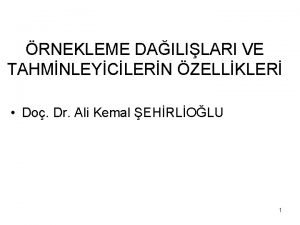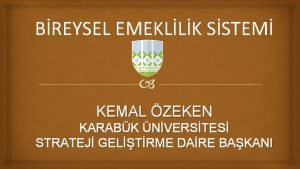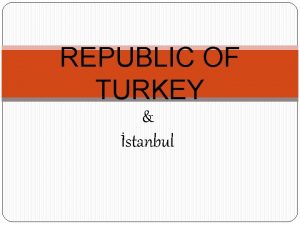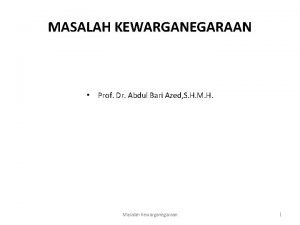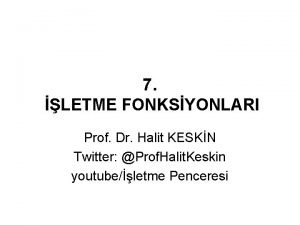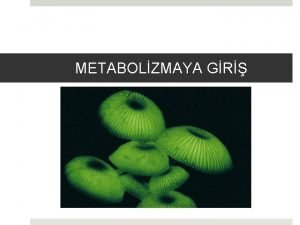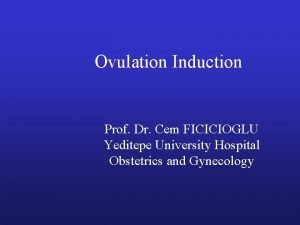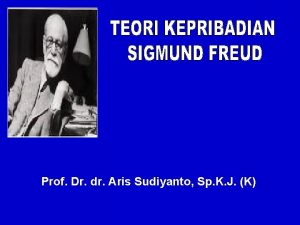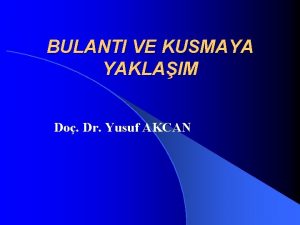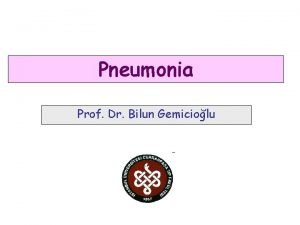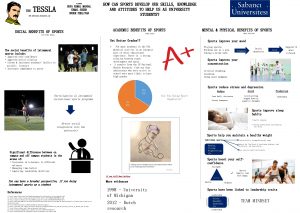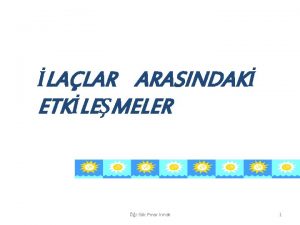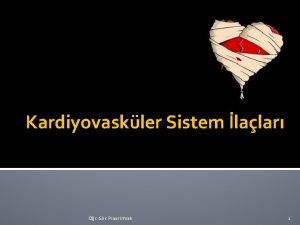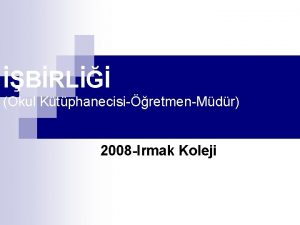M Kemal IRMAK MD Ph D Prof of










































- Slides: 42

M. Kemal IRMAK MD, Ph. D Prof. of Histology and Embryology, Ph. D of Biochemistry Ankara

Otic and nasal structures in Brain Cooling System

Sometimes our brains get hotter.

Overheated brain can lead to convulsions, fainting, and brain damage.

Computer Cooler Our brain is like a computer and needs cooling.

Brain is protected from thermal damage by a radiator system.

• As in a radiator of a car • Coolant poured into the radiator cools the hot motor of the car.

Brain is protected from thermal damage by a similar radiator system: Brain cooling system.

As brain gets hotter, the veins of this radiator system bring in cool blood from the evaporating surfaces of skin and craniofacial cavities.

sweat The cooling occurs through evaporation of sweat and mucus, and the transfer of the cool venous blood to the brain. mucus

Cool blood No evaporation, no cooling.

Major components of Brain Cooling System • nasal cavity (concha), • paranasal sinuses, • tympanic cavity, • certain parts of head skin.

Two kinds of veins transfer the cool venous blood to the brain 1. Angular vein 2. Emissary veins

Angular vein (a branch of facial vein): Drains cool venous blood from face, eye corners, nose, and lips to brain.

Emissary veins connect the intracranial veins with veins outside the cranium. They bring cool venous blood from scalp, posterior auricular region and nape (back of the neck) to brain.

All craniofacial regions contributing to cooling the brain with emissary and angular veins.

IMPORTANT! Washing or wetting these surfaces of the head (face, mouth, nose, scalp, nape and ears) a number of times helps the brain to remain cool throughout the day.

IMPORTANT! Nasal breathing Nasal, instead of mouth breathing is important for keeping the brain cool.

Nasal breathing cools the nasal blood and so the brain. Vessels in the concha

RULE The more surface area, the more cooling.

In hot climates as in Africa, -thick everted lips, -broader nasal cavity (wider nasal concha) -bigger paranasal sinuses provide more evaporating surfaces for an effective brain cooling.

Rule: The smaller brain, the easier cooling. Brain volume: 1450 cc in Eskimo, 1300 cc in Africa (No intelligence difference)

Coiled and spiraled hair in Africa helps the removal of the heat from the scalp and cools the brain.

Higher skin pigmentation absorbs the harmful ultraviolet rays of the sun and protects the body. How these changes occur?

How these changes occur? • The answer is: Biological Adaptation These geographic variations are due to direct environmental effects which, over many generations, became inherited.

How adaptive changes become inherited? • The answer is: Epigenetic inheritance system

In addition to the DNA inheritance system underlying classical genetics, there exists an epigenetic inheritance system.

In Epigenetic Inheritance System, heritable changes do not occur in the DNA sequence itself. The best known type of epigenetic modification is the methylation of DNA. The methyl group does not change the coding properties of the base, but may influence the gene expression.

Epigenetic modifications include modifications in the histones. modifications in the DNA bases

Epigenetic inheritance system allows humans to maintain stable patterns of gene expression over many generations, and enables organisms to acquire and transmit different phenotypes to the next generation. Methylation pattern is heritable

In epigenetic inheritance system while environmental factors produce modifications in the body, they induce long-term epigenetic modifications in the germ cells (oocytes) that are inherited to offspring.

Oocyte production takes a longer time than sperm production (12 -40 years vs. 60 days). Thus epigenetic modifications occur mostly in oocytes.

This long stage in women allows oocytes to establish many epigenetic modifications.

Important questions: • Is there a limit for epigenetic inheritance system? and • Is species-to-species evolution possible?

* There is a limit for epigenetic inheritance. Inheritance of adaptive changes is limited to embryonic neural crest. Neural crest cells migrate and give rise into different cell types.

Neural crest derivatives in the head facial tissues Leptomeninges (pia and arachnoid) pigment cells (Melanocytes) Merkel cells

Facial tissues (cartilage, bone and connective tissue) are derived from neural crest (including paranasal sinuses) Different facial features depend on difference in facial structures.

Pia and arachnoid mater are derived from neural crest. (Pia and arachnoid mater) Differences in cranial volume depend on pia and arachnoid mater.

Melanocytes are derived from neural crest Differences in pigmentation depend on melanocyte activity.

Merkel cells are derived from neural crest Differences in hair type depend on Merkel cells

CONCLUSION • Neural crest is the embryonic origin of human diversity. • Biological adaptation is limited to the structures of neural crest origin. • Therefore species-to-species evolution seems unlikely.

• For full-texts of articles • Mail to mkirmak@gata. edu. tr • Whats. App + 90 536 280 9830 Thank you for your interest.
 M. kemal irmak
M. kemal irmak Avolisyon
Avolisyon Beyaz adam paranın yenmeyen
Beyaz adam paranın yenmeyen Vostok gölü
Vostok gölü Kemal erkan
Kemal erkan Mustafa kemal'in çocukluk dönemi ve öğrenim hayatı
Mustafa kemal'in çocukluk dönemi ve öğrenim hayatı Kemal oflazer
Kemal oflazer Atatrk
Atatrk Etkin tahminleyici
Etkin tahminleyici Namık ismail'in son mermi adlı eseri
Namık ismail'in son mermi adlı eseri Nn words
Nn words Kemal akbay
Kemal akbay Hatay mustafa kemal üni yatay geçiş
Hatay mustafa kemal üni yatay geçiş Kemal huseinovic
Kemal huseinovic Kemal özeken
Kemal özeken 1881 turkey
1881 turkey Kemal oflazer
Kemal oflazer Kemal šanjta
Kemal šanjta Val.meb.k12 batman
Val.meb.k12 batman Yasar kemal zitate
Yasar kemal zitate Mukaddime i celal
Mukaddime i celal Prof abdul bari azed
Prof abdul bari azed Big ass prof
Big ass prof Prof dr enver özgencil
Prof dr enver özgencil Comprehensibilty
Comprehensibilty Halit keskin twitter
Halit keskin twitter Prof jatna supriatna
Prof jatna supriatna Science prof online
Science prof online Prof dr bektaş tepe
Prof dr bektaş tepe Prof sn singh
Prof sn singh Motorul otto
Motorul otto Prof przewratil
Prof przewratil Prof eco
Prof eco Ledo vacarro
Ledo vacarro Hipofosfatazi
Hipofosfatazi Nespresso prof
Nespresso prof Prof. dr. cem ficicioglu
Prof. dr. cem ficicioglu Prof jamasri
Prof jamasri Prof dr nafiye yılmaz
Prof dr nafiye yılmaz @prof.aline gaque
@prof.aline gaque Prof. dr. dr. aris sudiyanto, sp. kj (k)
Prof. dr. dr. aris sudiyanto, sp. kj (k) Prof yusuf akcan
Prof yusuf akcan Who classification of pneumonia
Who classification of pneumonia
